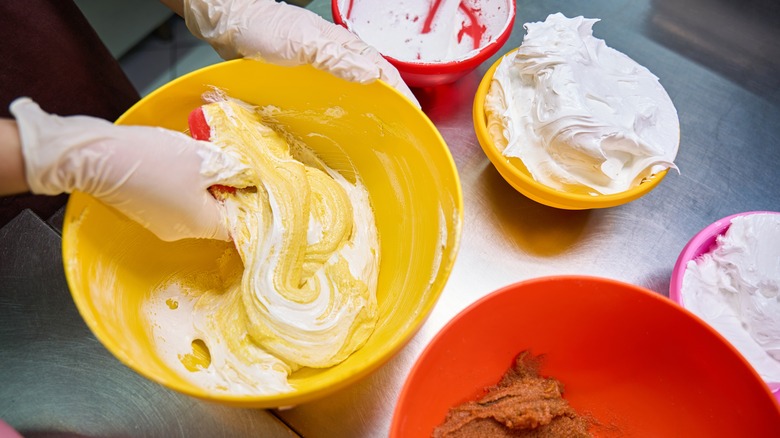The Telltale Sign That Your Macaron Batter Is Undermixed
Let's talk macarons (not to be confused with macaroons). They are a tricky cookie consisting of two light and airy meringue-and-almond-flour cookies and a sweet filling (think lemon curd or chocolate ganache). The cookies have a crisp macaron shell, light interior, and iconic "feet," a little ruffle-like structure that forms on the bottom as the cookies rise and provide the attractive frame for the filling.
There is no doubt that macarons are beautiful and delicious. However, making them comes with a long lists of do's, don'ts, and complicating factors (humid weather is the worst for making macarons). One of the most common errors aspiring macaron makers encounter is undermixing their batter. Luckily, there is one simple sign you can look for to indicate an undermixed cookie batter.
To test whether your batter is ready, use a silicone spatula to scoop some of your mix and lift it out of the bowl. If your batter is thick and falls from your spatula in clumps, you need to keep mixing your macaron base. On the other side of the mixing coin, if your batter is completely liquid and pours from your spatula in a thin ribbon, that indicates you have overmixed your macaron and deflated your meringue. The ideal macaron base is thick but pours from your spoon in a wide ribbon for about 10 seconds at a time.
Properly mixing your macarons
An undermixed base can spell disaster for these persnickety pastries. It can lead to dull, lumpy, and uneven shells that look more like baked meringue dollops than a delicate and delicious sandwich cookie. But it's a delicate balance to keep the right level of whipped airiness while fully incorporating the almond flour base to ensure your cookies rise in the oven and form a proper shell before cooking through.
Delicate but not impossible. It all comes down to the stirring technique, called "macaronage." An aggressive approach to mixing your batter inevitably results in flat macarons. On the other hand, too timid a hand can cause your batter to become lumpy. To properly incorporate the batter, sift in the almond flour and fold your meringue in gently, moving your spatula along the outside of the bowl and cutting through the middle with the spatula's edge. This should be slow, deliberate work. Don't stir or whisk as you would cookie dough or an icing, as this could deflate the egg whites too much. The goal is to remove the perfect amount of air; it should not turn into a liquid. The perfect batter is thick and shiny, great for piping. And once baked and sandwiched, perfect for snacking too.

